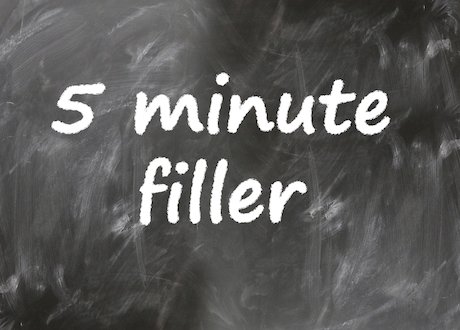5 Minute Filler
Add to My Folder
Occasionally, you may find that you need some quick activities to fill a few spare minutes, so here are some great ideas to get you going…

- Ask members of staff to bring in photos of when they were children. Display these on a board and get children to guess who is who. Children love to see what their teachers were like when they were younger, and it is a good activity for developing historical vocabulary.
- Pick a subject such as animals and tell the children three ‘facts’ – one that is true and two that are made up. For example, some camels have three humps, a zebra’s stripes change colour when they are scared and crickets have ears on their legs.
- Think of a member of the class and then play 20 questions where the children have to try and work out who you are thinking of by the questions they ask. Once children learn the best types of questions to ask, you could extend the game to famous people.
- If your class have fidgety feet, get them to stand up and arrange themselves in order of shoe size. This is great for developing communication skills as well as encouraging team work.
- Each morning start the day by telling the children a word to listen out for during your teaching, and make sure you use it during the day. Give children a signal to do to show they have heard the word, such as putting their thumbs on their nose.
- Get children to practise saying their times tables when they are lining up to go into the dinner hall. It helps keep everyone in check and considerably reduces chatter!
- Take close-up photographs of different objects or surfaces found in the classroom. Display the image on the whiteboard and invite children to identify the object and the material.
- Ask children to reply when they hear their name called on the register by clapping out the syllables. For example, Bethany would be three claps: Beth/a/ny.
- Display ten pictures of people and give children a list of ten professions or facts that could relate to them (for example, a doctor, grandma, scared of flying). Ask the children to match a label to each picture. This can be a fun game and is a great way to challenge stereotypes.
- Can your class guess how long a minute is? Challenge children to put up their hand when they think a minute has gone by, and use a stop watch to announce when the minute is up. Children will be surprised how long a minute actually is! Explore all the different things you could do that will last about a minute.
- Start each day with a statement on the whiteboard and let the children decide among themselves if it is ‘true’ or ‘false’. This is a great way to get children talking and exchanging views. Then, get your class to give a show of hands for each option and talk about their reasons for voting. End by revealing the answer!
- Sing a popular nursery rhyme or playground chant… but miss out all the words that begin with a certain letter. It’s harder than it sounds, so will take a bit of practice. This can make for a fun end-of-day challenge… especially if the children have to guess which ‘letter’ you are missing out each time.
- Photocopy a set of simple images or photographs and then cut each into quarters. Give every child in your class a quarter of one of the pictures and challenge them to find the three other children who will complete their picture. This is a good ice-breaker game and one that is ideal for emphasising team work!
- Play a dynamic piece of music, for example, the theme tune to Mission Impossible, to encourage children to change for PE more quickly. Children should be changed and lined up by the time the music ends.
- Help children develop their mathematical questioning by sticking a numbered sticky note on a child’s back. The rest of the class then describe the number, for example, it is even, it is bigger than ten, and so on. This game also works well for shapes.
- Write three words up on the board such as ‘cube’, ‘skate’, and ‘cream’. See if children can come up with one word that would make sense in front of all of these, like ‘ice’.
- Challenge children’s musical timing by getting your class to sing along with a song they know well. While the song is playing, turn the volume down. The challenge is for the children to keep time and still be singing the same part when you turn the sound back up.
- Play ‘animal addition’ by giving children a sum such as, ‘a zebra plus a spider’. Children have to think about how many legs the animals have, and then add them together – giving you the answer 12. This can work well with other things, such as sides of a shape. What’s a square plus a triangle?
- Write a message on the board in a secret agent code. Display the key to the code underneath and challenge children to decrypt the special message.
Log in to your account to read
Published 11 June 2019
Reviews
You need to be signed in to place a review.